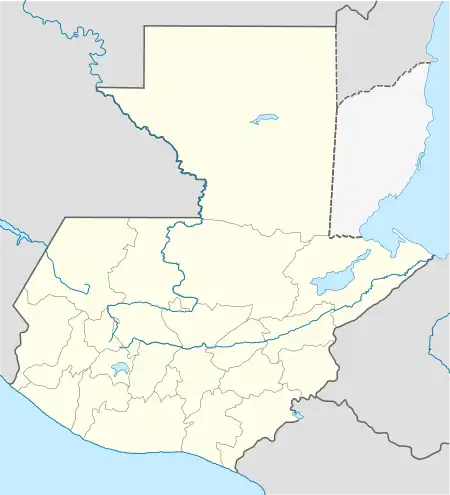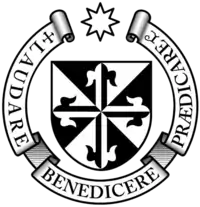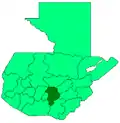San Juan Sacatepéquez
San Juan Sacatepéquez (Spanish pronunciation: [saŋ ˈxwan sakateˈpekes]) is a city, with a population of 155,965 (2018 census)[2] making it the eighth largest in Guatemala, and a municipality in the Guatemala department of Guatemala, northwest of Guatemala City. The city is known for flower-growing and wooden furniture.
San Juan Sacatepéquez | |
|---|---|
Municipality | |
 San Juan Sacatepéquez Location in Guatemala | |
| Coordinates: 14°43′8″N 90°38′39″W | |
| Country | |
| Department | Guatemala |
| Government | |
| • Mayor | Fernando Bracamonte (PP) |
| Area | |
| • Municipality | 113 sq mi (292 km2) |
| Population (2018 census)[1] | |
| • Municipality | 218,156 |
| • Density | 1,900/sq mi (750/km2) |
| • Urban | 155,965 |
| Climate | Cwb |
History
Doctrine of Order of Preachers

After the conquest, the Spanish crown focused on the Catholic evangelism of the natives. Settlements founded by royal missionaries in the New World were called "Indian doctrines" or simply "doctrines". Originally, friars had only temporary missions: teach the Catholic faith to the natives, and then transfer the settlements to secular parishes, just like ones that existed in Spain at the time; the friars were supposed to teach Spanish and Catholicism to the natives. When the natives were ready, they could start living in parishes and contribute with mandatory tithing, just as people in Spain did.[3]
But this plan never materialized, mainly because the Spanish crown lost control of the regular orders as soon as their friars set course to America. Shielded by their apostolic privileges granted to convert natives into Catholicism, the missionaries only responded to their order's local authorities, and never to that of the Spanish government or the secular bishops. The orders' local authorities, in turn, only dealt with their own order and not with the Spanish crown. Once a doctrine had been established, it protected its own economic interests, even against those of the King and thus, the doctrines became Indian towns that remains unaltered for the remainder of the Spanish colonial period.
The doctrines were founded at the friars' discretion, given that they were completely at liberty to settle communities provided the main purpose was eventually to transfer it as a secular parish which would be tithing of the bishop. In reality, what happened was that the doctrines grew uncontrollably and were never transferred to any secular parish; they formed around the locality of the monastery and from there, they would go out to preach to settlements that belong to the doctrine and were called "annexes", "visits" or "visit towns". Therefore, the doctrines had three main characteristics:
- they were independent from external controls (both ecclesiastical and civilian )
- were run by a group of friars
- had a relatively larger number of annexes.[3]
The main characteristic of the doctrines was that they were run by a group of friars, because it made sure that the community system would continue without any issue when one of the members died.[4]
In 1638, the Order of Preachers split their large doctrines, which meant large economic benefits for them, in groups centred around each one of their six monasteries, and the San Juan Sacatepéquez doctrine was moved under the Santiago de los Caballeros de Guatemala monastery jurisdiction:[5]
| Monastery | Doctrines |
|---|---|
| Santiago de los Caballeros de Guatemala |
|
In 1754, the Order of Preachers had to give away all of its doctrines and curatos to the secular clergy, as part of the Enlightened absolutism sponsored by the Spanish Monarch Carlos III.[6]
Climate
San Juan Sacatepéquez has temperate climate (Köppen: Csb).
| Climate data for San Juan Sacatepéquez | |||||||||||||
|---|---|---|---|---|---|---|---|---|---|---|---|---|---|
| Month | Jan | Feb | Mar | Apr | May | Jun | Jul | Aug | Sep | Oct | Nov | Dec | Year |
| Average high °C (°F) | 21.5 (70.7) |
22.6 (72.7) |
23.9 (75.0) |
24.4 (75.9) |
24.0 (75.2) |
22.5 (72.5) |
22.6 (72.7) |
23.0 (73.4) |
22.3 (72.1) |
21.5 (70.7) |
21.6 (70.9) |
21.6 (70.9) |
22.6 (72.7) |
| Daily mean °C (°F) | 15.6 (60.1) |
16.4 (61.5) |
17.3 (63.1) |
18.3 (64.9) |
18.4 (65.1) |
18.0 (64.4) |
17.9 (64.2) |
18.0 (64.4) |
17.6 (63.7) |
16.9 (62.4) |
16.4 (61.5) |
15.8 (60.4) |
17.2 (63.0) |
| Average low °C (°F) | 9.8 (49.6) |
10.2 (50.4) |
10.8 (51.4) |
12.3 (54.1) |
12.9 (55.2) |
13.6 (56.5) |
13.2 (55.8) |
13.0 (55.4) |
12.9 (55.2) |
12.4 (54.3) |
11.3 (52.3) |
10.1 (50.2) |
11.9 (53.4) |
| Average precipitation mm (inches) | 6 (0.2) |
4 (0.2) |
3 (0.1) |
37 (1.5) |
111 (4.4) |
250 (9.8) |
201 (7.9) |
201 (7.9) |
248 (9.8) |
122 (4.8) |
29 (1.1) |
6 (0.2) |
1,218 (47.9) |
| Source: Climate-Data.org[7] | |||||||||||||
Geographic location
Notes and references
References
- Citypopulation.de Population of departments and municipalities in Guatemala
- Citypopulation.de Population of the major cities in Guatemala
- van Oss 1986, p. 53.
- van Oss 1986, p. 54.
- Belaubre, Christopohe (2001). "Poder y redes sociales en Centroamérica: el caso de la Orden de los Dominicos (1757-1829)" (PDF). Mesoamérica. 41. Archived from the original (PDF) on 21 January 2015.
- Juarros 1818, p. 334.
- "Climate: San Juan Sacatepéquez". Climate-Data.org. Retrieved 19 September 2015.
- "Municipios del departamento de Guatemala". SEGEPLAN (in Spanish). Guatemala. Archived from the original on 7 July 2015. Retrieved 22 July 2015.
Bibliography
- Juarros, Domingo (1818). Compendio de la historia de la Ciudad de Guatemala (in Spanish). Guatemala: Ignacio Beteta.
- van Oss, Adriaan C. (1986). Catholic Colonialism: A Parish History of Guatemala, 1524-1821. Cambridge, UK: Cambridge University Press. ISBN 9780521527125.
